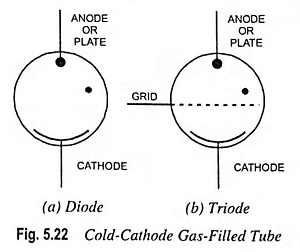Classification of Gas Filled Tubes:
Vacuum tubes are no doubt, extensively used in communication control and industrial electronic circuits, but these can carry small plate currents (typically from 1 mA to 100 mA). For certain applications much large currents (from 1 A to 100 A) are required. Gas-filled electron tubes are generally used for such applications. A gas filled tube is essentially a vacuum tube filled with a small amount of some inert gas at low pressure. The gas pressure in such tubes varies from 10 mm of mercury to 50 mm of mercury.
The gas-filled tubes are similar, in construction, to vacuum tubes with the exception that their electrodes (cathodes, grids and plates) are usually larger in size so as to carry heavy currents. The gas used in the tubes should not have oxidizing property as this reduces the life of the cathode. So inert gases, such as argon, neon, helium, krypton or xenon are used for such purposes.
Gas-filled tubes are normally classified according to the type of electron emission employed. On this basis they may be classified as
- Cold-cathode type and
- Hot-cathode type
In cold-cathode type gas-filled tube, the cathode is not heated, as in a vacuum tube, so electron emission from cathode do not occur because of thermionic emission. Actually the gas is ionized by energy available from natural sources such as cosmic rays, sun rays or radioactive particles in air. These natural sources are the underlying reasons for start of conduction in cold cathode gas-filled tube.
Cold-cathode gas-filled diode, also known as glow tube, is shown schematically in Fig. 5.22 (a). The dot within the circle indicates the presence of gas in the tube envelope. The most of the cold-cathode gas-filled tubes are used as diodes.
Cold-cathode gas-filled triode, also known as grid glow tube, is shown schematically in Fig. 5.22 (b).
In hot-cathode gas-filled tube, the cathode is heated up as in vacuum tubes. The electrons flowing from cathode to anode cause ionization of the gas molecules. Among the various gas tubes only gas diodes (or phanotrons) and gas triodes (or thyratrons) are commonly used.
